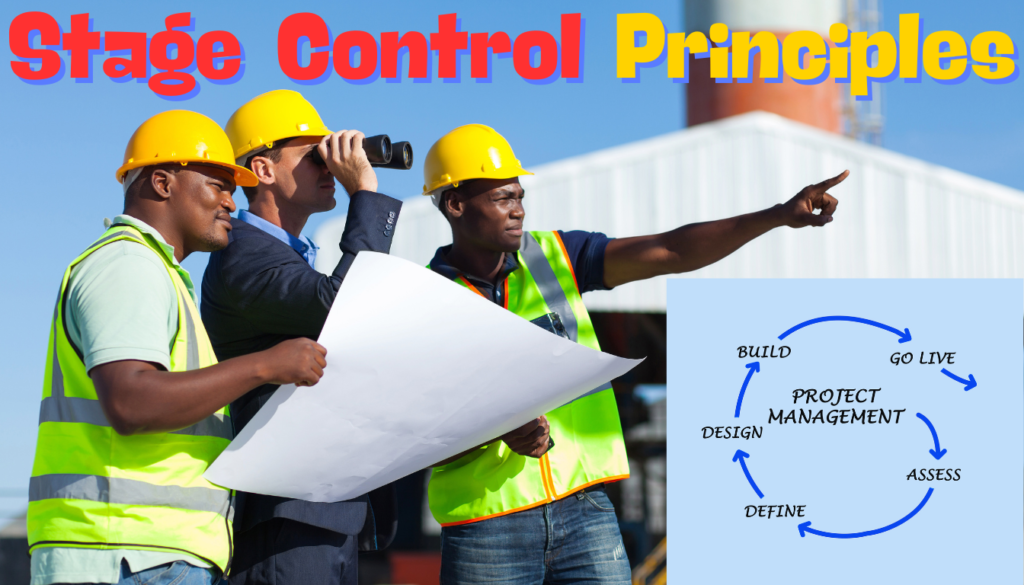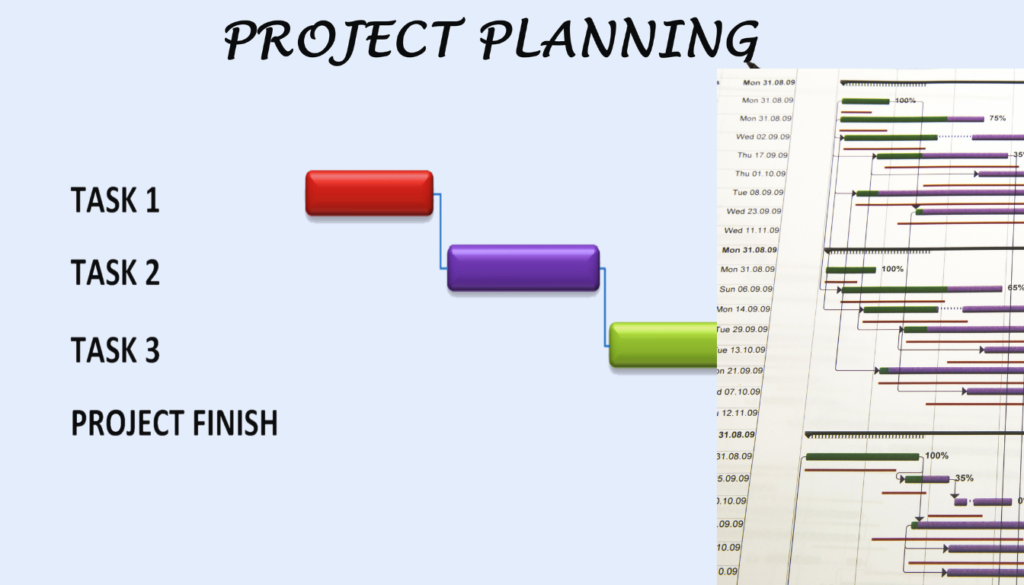Introduction
In project management, controlling the stage is an art that requires a delicate balance of strategy and execution. It’s the ability to navigate complex projects, anticipate challenges, and keep everything on track that separates the truly successful project managers from the rest.
Stage control involves setting clear objectives and deliverables for each stage, monitoring progress, managing resources, mitigating risks, and ensuring quality standards are met. By effectively controlling each stage, project managers can identify and address issues early, maintain alignment with project goals, and ensure a smooth transition between stages.
In this blog post, we will explore the key strategies for successful stage control in project management. We will delve into the principles of stage control, how to develop a stage control plan, techniques for monitoring progress and managing resources, and best practices for risk management, communication, and quality assurance.
Table of Contents
History of Stage Controlling in Project Management
| Time Period | Development | Description |
|---|---|---|
| Early 20th Century | Gantt Charts | Introduction of Gantt charts by Henry Gantt, which helped in visualizing project schedules and stages, allowing for better control and monitoring. |
| 1950s-1960s | Introduction of Project Management Techniques | Emergence of formal project management techniques and methodologies, such as Critical Path Method (CPM) and Program Evaluation and Review Technique (PERT), emphasizing stage control. |
| 1969 | Formation of Project Management Institute (PMI) | Establishment of PMI, which began to formalize project management practices, including stage control, through standardized guidelines and methodologies. |
| 1980s | Development of PRINCE (Projects IN Controlled Environments) | Introduction of the PRINCE methodology by the UK government, focusing on structured project management and control stages for IT projects. |
| 1996 | PRINCE2 Methodology | Launch of PRINCE2, an updated version of PRINCE, which provided a more comprehensive framework for managing and controlling projects in various stages. |
| 2000s | Growth of Agile Methodologies | Adoption of Agile methodologies like Scrum and Kanban, which introduced iterative stages and continuous control through sprints and daily stand-ups. |
| 2010s | Integration of Project Management Software | Emergence of advanced project management software (e.g., Microsoft Project, JIRA, Asana) that facilitated detailed stage planning, monitoring, and control. |
| Present | Emphasis on Hybrid Approaches | Use of hybrid project management approaches that combine traditional stage control methods with Agile practices to improve flexibility and control in complex projects. |
The Importance of Stage Control in Project Management
Stage control is a critical aspect of project management that ensures projects stay on track and are completed successfully. It involves effectively managing project phases, milestones, timelines, resources, and risks. Without proper stage control, projects can easily fall behind schedule, exceed budgets, and fail to meet objectives.
Overview of Progress
One of the key reasons why stage control is important is that it allows project managers to have a clear overview of the project’s progress and make informed decisions.
Monitoring and Controlling
By monitoring and controlling each stage, project managers can identify potential bottlenecks, risks, and deviations from the original plan. This enables them to take proactive measures to mitigate risks, resolve issues, and keep the project on track.
Resource Management
Stage control also plays a crucial role in resource management. By having a clear understanding of the project’s progress, project managers can allocate resources effectively, ensuring that each task is assigned to the right team member, and that resources are utilized optimally. This helps in maximizing efficiency and productivity, ultimately leading to successful project completion.
Effective Communication
Furthermore, stage control allows project managers to maintain effective communication with stakeholders. By keeping stakeholders informed about the project’s progress, challenges, and achievements, project managers can build trust and credibility. This ensures that stakeholders have realistic expectations and are actively involved in the decision-making process, leading to greater project success.
Key Components of Stage Control

Stage control encompasses several key components that project managers must focus on to ensure successful project execution. These components include defining clear objectives, setting realistic timelines, monitoring progress, dealing with unexpected challenges, and maintaining effective communication and collaboration.
Defining Clear Objectives
Clear objectives are the foundation of successful project management. Project managers must work closely with stakeholders to clearly define and document project objectives. This ensures that everyone involved understands the desired outcomes and can work towards achieving them. Clear objectives also provide a benchmark for measuring progress and success throughout the project.
Setting Realistic Timelines
Setting realistic timelines is crucial for effective stage control. Project managers must carefully estimate the time required for each stage and task, taking into consideration potential risks and dependencies. Unrealistic timelines can lead to rushed work, poor quality, and increased project risks. By setting realistic timelines, project managers can ensure that each stage has sufficient time for thorough execution, reducing the likelihood of delays and bottlenecks.
Setting Realistic Timelines
Setting realistic timelines is crucial for effective stage control. Project managers must carefully estimate the time required for each stage and task, taking into consideration potential risks and dependencies. Unrealistic timelines can lead to rushed work, poor quality, and increased project risks. By setting realistic timelines, project managers can ensure that each stage has sufficient time for thorough execution, reducing the likelihood of delays and bottlenecks.
Monitoring Progress
Monitoring progress is a continuous activity that project managers must engage in throughout the project lifecycle. By regularly tracking and reviewing the progress of each stage, project managers can identify any deviations from the plan and take corrective actions. Monitoring progress also enables project managers to identify potential risks and issues early on, allowing for timely interventions and mitigations.
Dealing with Unexpected Challenges
In project management, unexpected challenges are inevitable. Project managers must be prepared to tackle unforeseen obstacles and changes that may arise during each stage. This requires flexibility, adaptability, and problem-solving skills. By having contingency plans in place and being proactive in addressing challenges, project managers can minimize the impact of unexpected events on the project’s progress.
Communication and Collaboration
Effective communication and collaboration are essential for successful stage control. Project managers must establish clear lines of communication with team members and stakeholders, ensuring that everyone is well-informed and on the same page. Regular meetings, progress reports, and feedback sessions can facilitate effective communication and collaboration, fostering a positive project environment.
Key Principles of Stage Control

- Milestone Planning
- Establish clear milestones to review and assess progress.
- Detailed planning of what needs to be achieved at each stage.
- Importance of setting realistic and achievable milestones.
- Progress Tracking
- Regularly monitor the project’s progress against the plan.
- Use of project management tools for effective tracking.
- Importance of maintaining consistency in tracking methods.
- Risk Management
- Identify and mitigate potential risks at each stage.
- Develop a risk management plan.
- Continuous risk assessment and adjustment of strategies.
- Resource Allocation
- Ensure optimal utilization of resources.
- Planning resource allocation in advance.
- Adjusting resource allocation based on project needs.
The Role of Project Managers in Stage Control
Project managers play a crucial role in stage control, as they are responsible for overseeing and managing the entire project lifecycle. They are the driving force behind successful project execution and are accountable for delivering results. Project managers must possess a range of skills, including unforeseen events on the project’s progress and success. They must also be prepared to make difficult decisions and take corrective actions when necessary, ensuring that the project stays on track.
Additionally, project managers must continuously monitor and evaluate the project’s progress. They must regularly review key performance indicators, track milestones, and analyze project data to identify any deviations from the plan. This enables project managers to take timely actions to address issues, make adjustments to the project plan, and ensure that the project stays aligned with the overall strategic goals of the organization.
Developing a Stage Control Plan

Creating a comprehensive stage control plan involves defining clear objectives, setting milestones, and outlining the methods for monitoring progress. This plan serves as a roadmap for the project, guiding it through each phase.
Defining Objectives
- Clear and concise objectives for each stage.
- Aligning objectives with overall project goals.
Setting Milestones
- Breaking the project into manageable phases.
- Establishing specific milestones for progress review.
Monitoring Methods
- Tools and techniques for monitoring progress.
- Regular progress reviews and updates.
Monitoring Progress
Use project management tools to track progress against the plan. Regular progress reviews help identify any deviations from the plan, allowing for timely adjustments.
| Category | Details |
|---|---|
| Project Management Tools | Overview of popular tools: |
| – Asana: Task management, project timelines, team collaboration. | |
| – Trello: Visual boards, card-based task management, integrations. | |
| – Microsoft Project: Gantt charts, resource management, advanced scheduling. | |
| Features and benefits of using these tools: | |
| – Asana: Easy to use, customizable workflows, real-time collaboration. | |
| – Trello: Intuitive interface, flexible project views, seamless integrations. | |
| – Microsoft Project: Detailed project planning, robust resource allocation, comprehensive reporting. | |
| Regular Progress Reviews | Importance of consistent progress reviews: |
| – Ensures the project stays on track. | |
| – Identifies deviations from the plan early. | |
| – Allows for timely adjustments and interventions. | |
| Methods for conducting effective reviews: | |
| – Schedule regular review meetings. | |
| – Use project management tools to track progress. | |
| – Engage stakeholders in the review process. |
Managing Resources Effectively
| Category | Details |
|---|---|
| Resource Planning | Identifying resource needs for each stage: |
| – Assess the specific requirements for each project phase. | |
| – Determine the skills, tools, and materials needed. | |
| Planning resource allocation in advance: | |
| – Develop a resource allocation plan before project commencement. | |
| – Ensure resources are available when needed. | |
| Utilization and Adjustment | Ensuring optimal utilization of resources: |
| – Monitor resource usage to avoid under or over-utilization. | |
| – Implement strategies for efficient resource deployment. | |
| Adjusting resource allocation based on project needs: | |
| – Reallocate resources as project requirements change. | |
| – Be flexible and responsive to unforeseen challenges. |
Effective resource management ensures that the necessary resources are available and utilized efficiently at each stage. This involves planning resource allocation and adjusting as needed based on the project’s requirements.
Risk Management in Stage Control

Identifying potential risks early and developing strategies to mitigate them is crucial. This proactive approach helps in minimizing the impact of risks on the project’s progress.
- Risk Identification
- Methods for identifying potential risks.
- Importance of early risk identification.
- Risk Mitigation Strategies
- Developing strategies to mitigate identified risks.
- Continuous risk assessment and adjustment of strategies.
Communication and Stakeholder Engagement
Maintaining open lines of communication with stakeholders is essential. Regular updates and feedback sessions help in keeping everyone informed and engaged.
| Communication Strategies | Effective communication methods: |
| – Use clear and concise language. | |
| – Utilize multiple communication channels (e.g., email, meetings, chat). | |
| Importance of regular updates and feedback sessions: | |
| – Keeps everyone informed on project progress. | |
| – Allows for timely identification and resolution of issues. | |
| – Enhances team collaboration and morale. | |
| Stakeholder Engagement | Engaging stakeholders throughout the project: |
| – Involve stakeholders in planning and decision-making processes. | |
| – Schedule regular check-ins and update meetings. | |
| Methods for keeping stakeholders informed and engaged: | |
| – Provide regular progress reports and updates. | |
| – Use project dashboards and status reports. | |
| – Encourage feedback and address concerns promptly. |
Decision Making and Issue Resolution
Timely decision-making and effective issue resolution are vital for maintaining project momentum. Establish a clear process for addressing issues as they arise.
- Decision-Making Process
- Establishing a clear decision-making process.
- Importance of timely decision-making.
- Issue Resolution
- Effective methods for resolving issues.
- Importance of addressing issues promptly.
Ensuring Quality Control

Quality control measures should be integrated into each stage of the project. Regular quality checks help in maintaining the project’s standards and meeting its objectives.
- Quality Control Measures
- Developing quality control measures for each stage.
- Importance of regular quality checks.
- Maintaining Standards
- Ensuring the project meets its standards.
- Methods for maintaining quality throughout the project.
Transitioning Between Stages
Smooth transitions between stages are crucial for maintaining project continuity. Ensure that all necessary tasks are completed and reviewed before moving to the next stage.
| Category | Details |
|---|---|
| Transition Planning | Planning for smooth transitions between stages: |
| – Develop a detailed transition plan for each stage. | |
| – Communicate transition plans clearly to all team members. | |
| Importance of completing and reviewing tasks before transitioning: | |
| – Ensure all tasks are completed and reviewed before moving to the next stage. | |
| – Conduct thorough reviews to identify and address any issues. | |
| Maintaining Continuity | Ensuring continuity throughout the project: |
| – Maintain consistent project documentation. | |
| – Keep all team members informed and aligned with project goals. | |
| Methods for maintaining project continuity: | |
| – Use project management tools to track progress and updates. | |
| – Regularly update project plans and schedules. | |
| – Hold frequent team meetings to ensure alignment and address any disruptions. |
Best Practices for Controlling the Stage
| Category | Details |
|---|---|
| Regular Reviews | Conduct regular progress reviews to stay on track: |
| – Schedule regular review meetings. | |
| – Use project management tools to monitor progress. | |
| Importance of consistent and thorough reviews: | |
| – Identifies issues early and allows for timely adjustments. | |
| – Ensures the project remains aligned with goals and objectives. | |
| Clear Documentation | Maintain clear and detailed documentation of each stage: |
| – Document all activities, decisions, and changes. | |
| – Ensure documentation is accessible to all team members. | |
| Importance of documentation for project success: | |
| – Provides a reference for future stages and projects. | |
| – Enhances transparency and accountability. | |
| Stakeholder Involvement | Engage stakeholders throughout the project: |
| – Involve stakeholders in planning, reviews, and decision-making. | |
| – Regularly update stakeholders on project progress. | |
| Methods for ensuring stakeholder involvement: | |
| – Use regular meetings, reports, and updates. | |
| – Encourage stakeholder feedback and address their concerns promptly. |
Conclusion and Final Thoughts
Mastering the art of stage control in project management is essential for ensuring that projects are completed successfully, on time, and within budget. By understanding and implementing effective stage control practices, project managers can maintain better oversight, optimize resource allocation, and achieve project objectives with greater efficiency.
Throughout this blog post, we have explored the fundamental aspects of stage control, including its definition, benefits, and key elements. We have discussed the importance of developing a comprehensive stage control plan, monitoring progress, managing resources, mitigating risks, and ensuring quality control. Additionally, we have highlighted the significance of regular progress reviews and effective communication with stakeholders.
Stage control provides a structured approach to managing projects, enabling project managers to identify and address issues early, maintain alignment with project goals, and ensure smooth transitions between stages. By setting clear objectives, defining milestones, and using appropriate tools and techniques, project managers can enhance their ability to deliver successful projects.
Final Thoughts
The success of any project largely depends on the effectiveness of its management processes, and stage control is a crucial component of this. As you continue to develop your project management skills, remember the importance of stage control in maintaining project direction and achieving desired outcomes. Embrace the strategies and best practices discussed in this post to enhance your project management capabilities and drive your projects to success.
By integrating these principles into your project management approach, you can navigate the complexities of projects more effectively, ensuring that each stage is meticulously planned and executed. Whether you are an experienced project manager or just starting out, mastering stage control will significantly contribute to your overall project success.
Call to Action
If you found this blog post informative, be sure to subscribe to our newsletter for more insights and updates on project management best practices. Share this post with your colleagues and fellow project managers to spread the knowledge and encourage effective stage control practices. Let’s continue to achieve project excellence together!
FAQ
What is stage control in project management?
Stage control in project management refers to the systematic process of managing and overseeing each distinct phase of a project. This involves setting clear objectives, monitoring progress, managing resources, mitigating risks, and ensuring quality standards are met before moving on to the next phase.
Why is stage control important in project management?
Stage control is crucial because it ensures that each phase of the project is completed successfully, allowing for early identification and resolution of issues, efficient resource management, and alignment with project goals. It helps maintain project direction and increases the likelihood of achieving desired outcomes.
How do you develop a stage control plan?
Developing a stage control plan involves defining clear objectives for each stage, setting milestones, outlining tasks, allocating resources, and establishing methods for monitoring progress. This plan serves as a roadmap, guiding the project through each phase systematically.
What are the key elements of stage control?
The key elements of stage control include setting clear objectives, developing a detailed plan, monitoring progress, managing resources, mitigating risks, ensuring quality control, and conducting regular progress reviews. These elements help ensure that each stage is managed effectively.
What tools are commonly used for stage control in project management?
Common tools for stage control include project management software like Asana, Trello, and Microsoft Project. These tools help in planning, tracking progress, managing resources, and communicating with stakeholders. They provide features that facilitate effective stage control.
How do you monitor progress during a project stage?
Progress during a project stage can be monitored using key performance indicators (KPIs) and metrics, regular progress reviews, and project management tools. Tracking progress against the plan and conducting periodic evaluations help ensure that the project stays on track.
What are some common challenges in stage control and how can they be addressed?
Common challenges in stage control include scope creep, resource constraints, and unforeseen risks. These can be addressed by setting clear objectives, maintaining a detailed plan, conducting regular risk assessments, and using effective communication strategies to manage stakeholder expectations.

